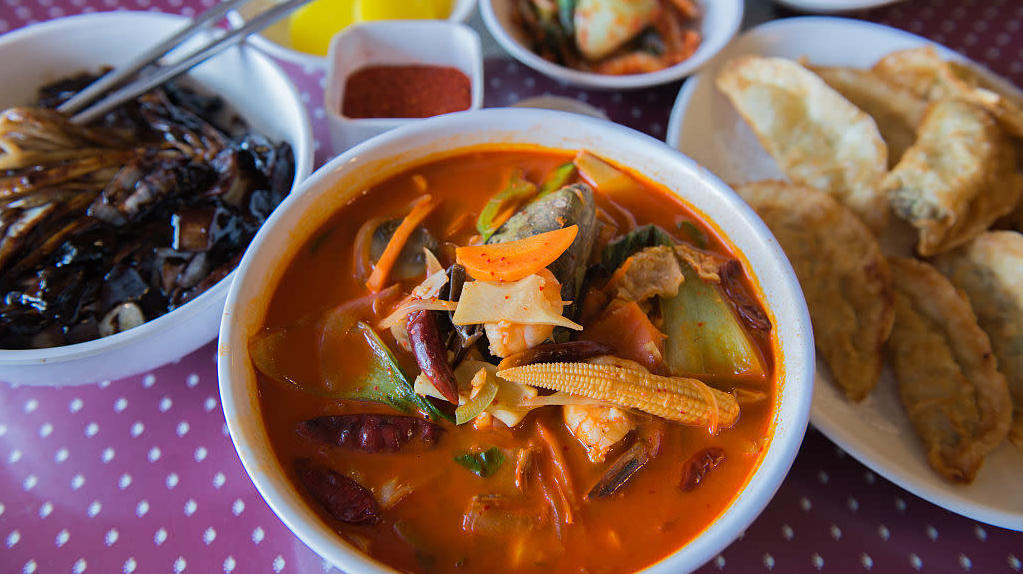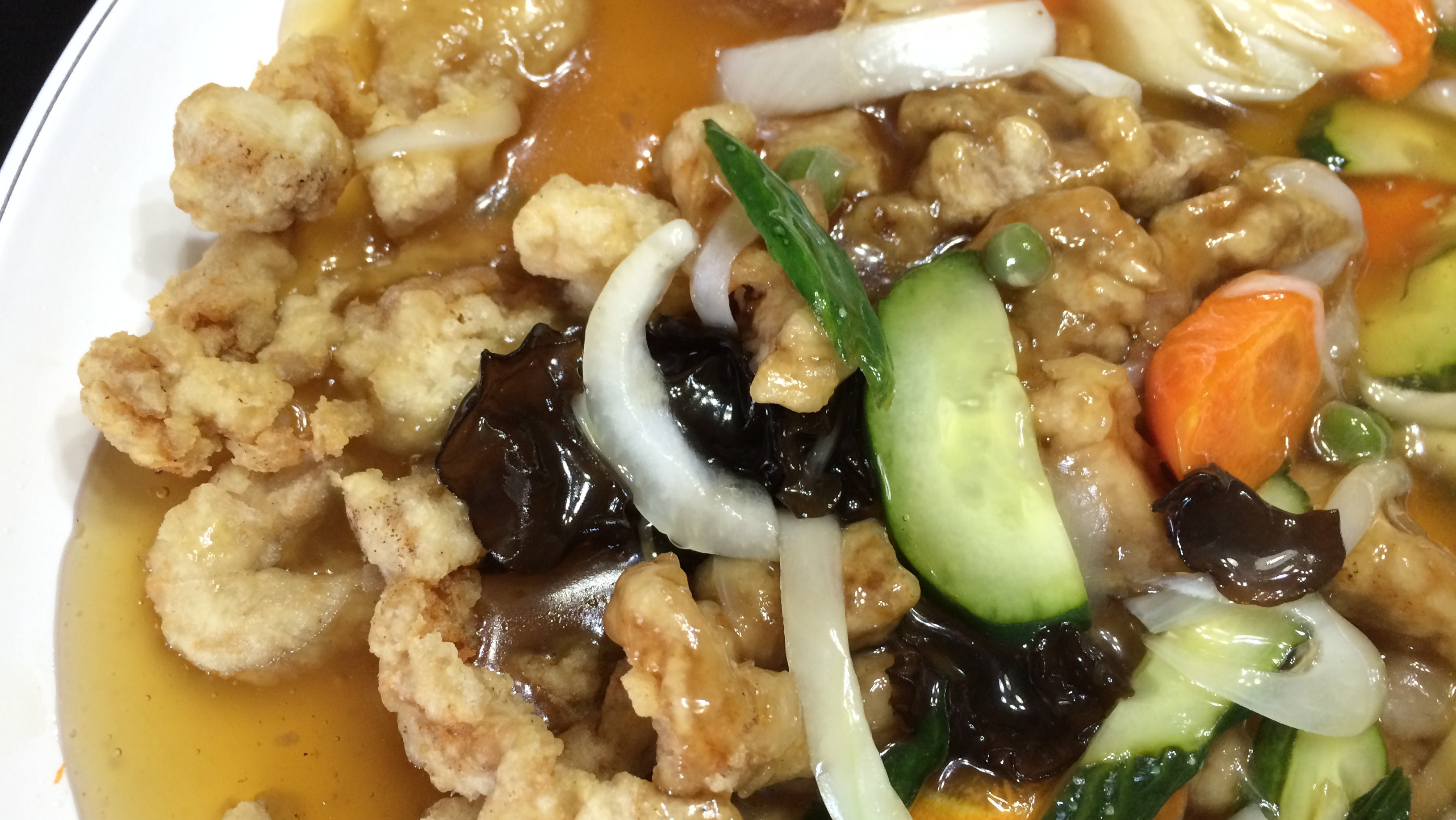A 60-Second Intro To Korean-Chinese Food
Chinese-American food is a staple of many people's takeout rotations, and we all have our favorite orders. When you crave it, you crave it. But there's a lesser-known variation on Chinese food that isn't often mentioned: Korean-Chinese food. It's stealthy, so stealthy that the local Chinese restaurant you've been going to for decades, may in fact be a Korean-Chinese restaurant and you've never known it.
Many Korean-Chinese restaurants often serve Chinese-American favorites, like kung pao chicken, pepper steak, and crab rangoons. But the telltale sign that you're enjoying food from a Korean-owned Chinese restaurant is the presence of three dishes on the menu: jjajangmyeon, jjampong, and tangsuyuk.
Just a fun language note, and something I feel like people don't really address—notice the double j before jjajangmyeon and jjampong? The reason for the double J's is that in Korean, the pronunciation is kind of like a cross between a G (as in "general") and a "J" sound, with a staccato delivery, pronounced just in one go. (A single "j" is a hard "J" sound.) That extra letter is there for a practical reason and not just to show how excited we get over a hot bowl of jjampong (or budae jjigae).
One other fun thing: Another sign that you're at a Korean-Chinese restaurant is that before your main course, you'll often be served a small dish of onions and yellow pickled radish, accompanied with a side of black bean sauce. While these raw onions and radish may look mysterious, you're supposed to douse the onion portion—and I mean, make it rain—with the white vinegar that'll also be on the table. Let the onions steep for a little bit, then dip them in the black bean sauce and snack on them before your meal arrives. There's no avoiding onion breath, but provided everyone at the table eats some raw onions, who's going to notice?
The history of Korean-Chinese cuisine
This video is a good rundown of how Chinese immigrants to Korea shaped those same dishes that are beloved in Korean-Chinese restaurants today. The short of it is that Korean-Chinese food is, at its heart, Chinese, but those Chinese dishes were tweaked to match the flavor preferences of Koreans. The biggest influx of Chinese immigrants to Korea began in the early 1900s, and many settled in Incheon, where Korea's first Chinatown was established.
Incheon is considered the cradle of Korean-Chinese food, and if it weren't for the Chinese immigrants, we wouldn't have these three dishes that are loved by Koreans so deeply today. When Koreans immigrated to America, they brought this food with them and served it in Chinese restaurants that cater to these specific tastes. But they also wanted to appeal to a wider American audience as well, which is the reason why you'll still see Chinese-American favorites on the menu.
Jjajangmyeon
Jjajangmyeon is a dish of wheat flour noodles (I'd describe them as fat spaghetti) in black bean sauce. Since the sauce is jet-black, it's hard to see what's in it, but you'll usually find diced pork, cubes of potato, bits of onion, and zucchini, and sometimes carrot or mushrooms too. It's served with julienned cucumber on top, which you just mix in, and a side of bright yellow sweet pickled daikon radish, which cuts through the richness of the sauce. It's classified as a comfort food, and after your first bite, you'll understand exactly why.
These noodles are deeply savory, thanks to the fermented black bean paste. Black bean paste is not a typical ingredient in most Korean dishes; this is a heavy nod to Chinese cooking, where the use of black bean paste is way more prevalent. For the record, this is one of my favorite dishes in the world. It's also a potential mess, as you stir the black bean sauce into the noodles yourself, and if you're a slurper, well. Watch your clothes and your glasses.
Instant jjajangmyeon has gotten a bump in popularity after it appeared, mixed with ramen, in the movie Parasite. You know it's not the real thing, but it's still awesome, sort of like the way frozen pizza is when compared to fresh pizza.
Jjampong
Jjampong is a bright red spicy seafood noodle soup. When I say bright red, I'm warning you, I've eaten some nuclear versions that really took me for a ride. It's sort of considered jjajangmyeon's sibling. One is almost never on a menu without the other, and sometimes you'll even see them served in a bowl that's split in half with one on each side.
For some reason, fewer people know about jjampong, but that doesn't mean it's any less delicious than jjajangmyeon. A typical bowl will have mussels or clams, shrimp, octopus, a little bit of pork, and a hefty portion of the same wheat noodles you'll find in jjajangmyeon, all in a flaming hot red broth, seasoned with gochugaru (Korean red pepper powder).
Tangsuyuk
If you've never had tangsuyuk, which is the Korean version of sweet and sour pork (or beef), I'm super excited to be the one to introduce this to you. When I was growing up, this was what I considered sweet and sour pork. The first time I had the Chinese-American version as a college student and saw the takeout container with its transparent bright pink sauce, I thought the place given me the wrong thing by mistake. Then I realized in a weird sort of shock that this was a different dish altogether.
Let's start with the meat. Instead of puffy battered round pieces, Korean sweet and sour pork is cut into strips which are coated in a batter of corn or potato starch, then fried twice. The second fry is important, as it gives you an ultra-crunchy strip that stays very crisp even after it's doused in sauce.
Next, the sauce: tangsuyuk sauce is a golden in color and translucent. It gets its sweetness from sugar, the sourness from vinegar, and the slight brown hue from a touch of soy sauce. It's thickened with a cornstarch slurry. You'll also usually find some combination of wood ear mushrooms, onions, bell pepper, pineapple, or cucumber mixed in, which makes for a nice fresh crunch against the heartier crispy meat.
Next time you're in the mood for Chinese food, try looking closer at the menu. If you see any of these dishes on there, give them a shot. There's a reason they're so popular in Korea, and it's a great introduction into one particular version of Korean comfort food that's steeped in Chinese origins.

